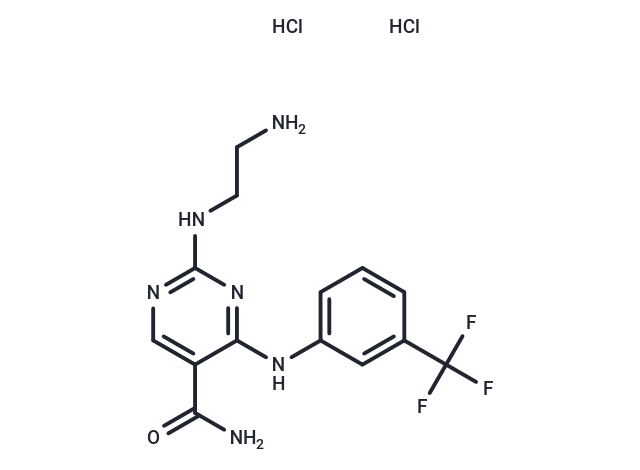Shopping Cart
- Remove All
 Your shopping cart is currently empty
Your shopping cart is currently empty

Spleen tyrosine kinase (Syk) is a non-receptor tyrosine kinase that, upon phosphorylation, binds to immunoreceptor tyrosine-based activation motifs of FcRγ chains and mediates downstream signaling related to platelet function and inflammation. Syk inhibitor II is a cell-permeable, pyrimidine-carboxamide compound that selectively and reversibly blocks Syk (IC50 = 41 nM) in an ATP-competitive manner. It is much less potent against PKCε, PKCβII, ZAP-70, Btk, and Itk (IC50s = 5.1, 11, 11.2, 15.5, and 22.6 μM, respectively).

| Pack Size | Price | Availability | Quantity |
|---|---|---|---|
| 1 mg | $132 | In Stock | |
| 2 mg | $223 | In Stock | |
| 5 mg | $479 | In Stock | |
| 10 mg | $682 | In Stock | |
| 25 mg | $996 | In Stock | |
| 50 mg | $1,330 | In Stock | |
| 100 mg | $1,790 | In Stock | |
| 1 mL x 10 mM (in DMSO) | $479 | In Stock |
| Description | Spleen tyrosine kinase (Syk) is a non-receptor tyrosine kinase that, upon phosphorylation, binds to immunoreceptor tyrosine-based activation motifs of FcRγ chains and mediates downstream signaling related to platelet function and inflammation. Syk inhibit |
| Targets&IC50 | ITK:22.6 μM, Syk:41 nM, PKCβII:11 μM, PKCε:5.1 μM, ZAP70:11.2 μM, BTK:15.5 μM |
| In vitro | Syk inhibitor II has been shown to prevent FcεRI-mediated 5-HT release in RBL-2H3 cells in vitro (IC50 = 460 nM). |
| In vivo | Syk inhibitor II has been shown to inhibit passive cutaneous anaphylaxis reactions in mice (ID50 = 13.2 mg/kg, s.c.). |
| Kinase Assay | A 2 μM portion of DMSO solution of each compound to be tested was added to each well containing 50 ll of a reaction solution [composition: 20–200 ng of recombinant kinase, 50 mM Tris–HCl (pH 7–8), 10 mM MgCl2 or MnCl2, 50 mM NaCl, 1 mM DTT, optimum concentration of the substrate peptide, and 0.1 lCi [c 33P]ATP (10 mCi/mL, Amersham)]. This was prepared in OptiplateTM (PACKARD) and allowed to stand at room temperature for 1 h to effect tyrosine phosphorylation. The reaction was terminated by adding PBS containing 0.25 mg SPA beads, 50 lM ATP, 5 mM EDTA, and 1% Triton X-100 in an amount of 150 ll per well. The plate was sealed, stirred, allowed to stand at room temperature for 15 min, and then centrifuged at 1500 rpm for 3 min to effect precipitation of the SPA beads. Radioactivity of each well was measured using TOP COUNT (PACKARD), and the tyrosine phosphorylation activity by the kinases was calculated. They are for reference only. |
| Animal Research | ICR mice were passively sensitized by subcutaneously injectinganti-dinitrophenyl (DNP)-coupled IgE under the right ear pinna, while lightly anesthetizing with ether. After 24hr, each mouse was challenged by injecting amixture of DNP-conjugated bovine serum albumin and 200 μl of 0.5% Evans blue solution via the tail vein to induce passive cutaneous anaphylaxis. Thirty minutes after the challenge, the mice were sacrificed to take both ears and the amount of dye from the blueing region was measured. Test compounds or vehicle alone as a control were subcutaneously administered to the mice 30 minbefore the antigen challenge. The dye in the tissues was extracted with formamide and colorimetrically determined at 620 nm. A value obtained by subtracting the dye content of the left ear from the dye content of the right ear was used as the amount of dye leaked into the tissues by the PCA reaction. |
| Alias | Syk Inhibitor II (hydrochloride) |
| Molecular Weight | 413.22 |
| Formula | C14H17Cl2F3N6O |
| Cas No. | 227449-73-2 |
| Smiles | Cl.Cl.NCCNc1ncc(C(N)=O)c(Nc2cccc(c2)C(F)(F)F)n1 |
| Relative Density. | no data available |
| Storage | Powder: -20°C for 3 years | In solvent: -80°C for 1 year | Shipping with blue ice. |
| Solubility Information | PBS(pH7.2): 10 mg/mL (24.2 mM), Sonication is recommended. Ethanol: 0.3 mg/mL (0.73 mM), Sonication is recommended. DMSO: 11 mg/mL (26.62 mM), Sonication is recommended. |

Copyright © 2015-2025 TargetMol Chemicals Inc. All Rights Reserved.